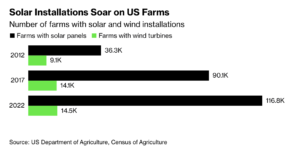Beef prices are projected to continue increasing as U.S. beef production declines with no signs of a cattle herd rebuild. Additionally, cheap beef may soon become further out of reach…
Farmers Continue Embracing Solar Panels
Bloomberg’s Ilena Peng, Michael Hirtzer, and Will Wade reported Thursday that “farmers are increasingly embracing solar as a buffer against volatile crop prices and rising expenses. Their incomes are heading for a 26% slide this year, the biggest drop since 2006, as cash receipts for corn, soy and sugar cane are expected to drop by double-digit percentages.”
“The shift is a big part of the renewables push in the US: The American Farmland Trust estimates that 83% of expected future solar development will take place on agricultural soil,” they reported. “…The movement is certain to get a kick from President Joe Biden’s Inflation Reduction Act, which has helped accelerate the clean energy boom through tax incentives for solar developers.”

Current State of Solar on Ag Land
AgWeb’s Stephanie Mercier wrote in February that 2022 Census of Agriculture data shows that “the number of farms with solar panels increased by nearly 30 percent between 2017 and 2022, while the number of wind turbines owned by farmers rose more modestly, by 2.6 percent, while wind turbines placed on leased land by outside firms rose by 2 percent.”
That solar panel increase of 30% equates to “more than 116,000 farms (that) had solar panels in 2022,” Peng, Hirtzer and Wade reported.
“Due to improved solar technology over the last few decades, energy generated with solar panels is deemed to be the cheapest source of energy of any kind (renewable or fossil-based) at $0.06 to $0.08 per kilowatt-hour, even when taking into account its intermittent availability, by the International Energy Agency,” Mercier wrote.
“Because renewable energy can be costly to set up, some farmers are leasing their land to developers, who typically cover installation expenses and own the generated electricity,” Peng, Hirtzer and Wade wrote. “Others have installed their own panels, selling the energy back to the grid to offset the costs of powering their farm.”
Farmer Concerns
Peng, Hirtzer and Wade wrote that “some farmers worry that the (solar) trend will accelerate a shrinking of farm fields. …Solar panels are ‘covering up so much of the most fertile, productive farmland in the world,’ said Ben Riensche, an Iowa corn and soybean farmer. ‘Someday, people will have electricity to run their Tesla, but no food.'”
Many of those farmers who have concerns about renewable energy overtaking prime farmland may have firsthand experience with those renewable energy companies. That’s because, Successful Farming’s Chuck Abbott reported Wednesday, “more than half of large U.S. farmers say they have been offered at least $1,000 an acre during discussions about planting solar panels instead of crops on their land, said a Purdue University poll released on Tuesday. Bids have climbed rapidly since 2021, when the most common offer was less than $750 an acre.”
“Productive farmland in the Midwest can produce corn and soybeans worth $1,000 an acre, but expenses including seed, fertilizer, pesticides, and equipment can dramatically reduce net revenue,” Abbott wrote. “The conversion of farmland to wind or solar power has raised hackles in rural America in recent years, and there have been efforts to block the developments.”
“Twice as many farmers are interested in solar leases than are interested in being paid to capture carbon on their land, said Purdue,” according to Abbott’s reporting. “Carbon contracts offer much lower payment rates, perhaps $20 an acre or so, and may require farmers to alter their practices.”
Those types of farmer concerns prompted a response from U.S. Agriculture Secretary Tom Vilsack while he was announcing $2.2 billion for rural electric cooperatives on Wednesday, when he said that “we know that there are some concerns out there about whether renewable energy will overtake prime farmland,” according to reporting from Successful Farming’s Chuck Abbott.
“‘We’re obviously encouraging use of non-prime farmland for purposes of renewable energy,’ said Vilsack, speaking at the National Rural Electric Cooperative Association’s annual meeting in San Antonio,” Abbott wrote. “Discussion of renewable energy projects should include an examination of how farming might be impacted, he said.”





